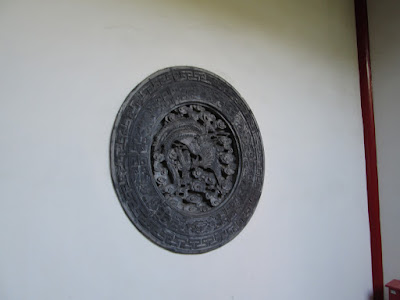With my visiting of both Sun Yat-sen's mausoleum and the Ming Filial Tombs at an end, I spent the next few minutes leisurely walking around the nature-filled avenues of Sun Yat-sen National Park in search of a taxi to take me to my next destination, "The Presidential Palace" (总统府).
 |
| The scenery was exceptional, so I wasn't in any rush to leave |
It wasn't long before I caught a taxi, and twenty minutes later I saw my first view of the palace, which didn't leave me very optimistic about how it would be on the inside:
Once inside the compound, however, the palace did an outstanding job of showing off its long and colourful history.
 |
| A man dressed up as Chiang Kai-shek (蒋介石), who would allow you take your photo with him for 60RMB |
You see, dear reader, the palace originally started as the administrative compound for all of south-eastern China during the Qing Dynasty (清代,1644-1912), the most populous and rich area in all of China.
Since the emperor lived far away to the north in Beijing (北京), the local officials who administered from the compound were, therefore, some of the most powerful men in China.
The administrative compound became an actual palace, however, during the time of the Taiping Rebellion and the brief establishment of the Heavenly Kingdom of Great Peace (太平天国, 1850-1864).
The leader of the Taiping, a man named Hong Xiuquan (洪秀全, 1814-1864), was a failed scholar who believed he was the brother of Jesus Christ, and asserted that it was his duty to overthrow the Qing Dynasty and convert all of China to his version of Christianity.
 |
| This room was where Hong would secretly discuss affairs of state and various pieces of governmental documentation |
The Taiping grew to have more than 30 million loyal followers, and overran much of southern China. When Nanjing was captured in 1853, its name was changed to Tianjing, or "The Heavenly Capital" (天京), and Hong set up his government in this former administrative center.
 |
| The Throne Room of the "Heavenly King" Hong Qiuquan |
The Taiping would have probably destroyed the Qing had it not been for the assistance of the British and French colonial armies, which was finally put down - after causing around 20 million casualties - by 1864.
 |
| Hong Xiuquan's study room |
After the Taiping Rebellion, the palace regained historical importance once again in 1912, becoming the presidential palace for Sun Yat-sen and his Nationalist Party or Guomindang (国民党), for the newly-founded Republic of China (中华民国).
 |
| "The World Belongs to the Masses" |
Sun Yat-sen had a smaller structure built on the palace grounds to house his government, which still survives to this day. The inside of the building has been converted into a museum.
While Sun was forced from the presidency - as well as the palace - only a few months after he gained the position, the palace was used again years later by the Guomindang - then led by Chiang Kai-shek (蒋介石) - as the seat of governmental power after the Guomindang reunified China in 1928.
Like Sun Yat-sen before him, Chiang Kai-shek had a completely new structure built on the palace grounds for his government, completed by 1936.
The building was only used for a single year by Chiang's government, however, as the Japanese began their invasion into China in 1937, forcing the Guomindang to flee both the palace and Nanjing. The Japanese then set up a puppet government to rule the portions of China they conquered, using the palace as an administrative center.
Chiang's government regained the palace in 1945 after the Japanese were defeated, and used the palace as their seat of government before once again being forced to flee, this time by the Chinese Communists, in 1949.
Under the Communists, the palace served as minor governmental offices until being refurbished into a very entertaining tourist attraction in 2000.
My unexpectedly wonderful tour of the presidential palace complete, I made my way to the last place of interest I wanted to see in Nanjing, which I shall cover in my next blog post.
Until next time!
























































No comments:
Post a Comment